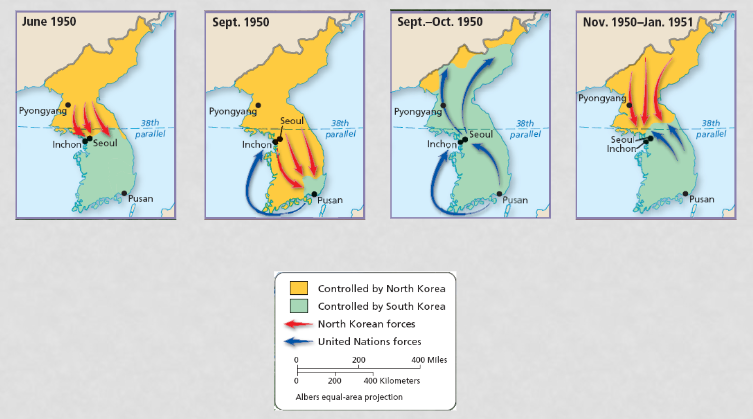Korean War
The Main Idea
Cold War tensions finally erupted in a shooting war in 1950. The United States confronted a difficult challenge defending freedom halfway around the world.
Korea before the war
- Japan made Korea a colony in 1910 due to its reserves of coal & iron.
- After World War II, Japanese-occupied Korea was temporarily divided into northern and southern parts.
- The Soviet Union controlled Korea north of the 38th parallel. The United States would be in charge of Korea south of the 38th parallel.
- The Soviet Union established a communist government in North Korea. North Korea called itself the Democratic People’s Republic of Korea. Its first leader was Kim Il Sung.
- In South Korea, the United States promoted a democratic system. The Republic of Korea was led by president Syngman Rhee.
The start of the Korean War
- North Korea invaded South Korea on June 25, 1950.
- Most leaders in the United States were surprised by this attack.
- American troops stationed in South Korea since WWII had recently completed their withdrawal.
- The United States was not well prepared to fight in Korea; however, the decision to fight was made quickly.
- Truman decided that the United States would take a stand against Communist aggression in Korea.
- The United Nations Security Council voted unanimously* in favor of the use of force in Korea.
Truman’s Decision
June 27th - Truman orders US air and naval forces to assist South Korea, without consulting Congress
- Communism was acting in Korea, just as Hitler, Mussolini and the Japanese had…years earlier. If the Communists were permitted to force their way into the Republic of Korea without opposition from the free world, no small nation would have the courage to resist threat and aggression by stronger communist neighbors. - Harry S Truman
Role of the United States
- South Korea was where the United States had to take a stand against Communist aggression.
- Truman ordered American naval and air forces to support Korean ground troops.
- Truman asked the United Nations to approve the use of force to stop the North Korean invasion.
Role of the United Nations
- The UN Security Council supported the use of force in Korea.
- Truman sent ground troops to Korea.
- The troops sent to Korea were to be a United Nations force.
- Instead of calling this a war, the whole effort was referred to as a UN police action.
COMBAT IN THE KOREAN WAR
The Inchon Landing
- UN forces made an amphibious landing behind North Korean lines at the port city of Inchon.
- MacArthur’s surprise attack worked beautifully.
- The September 1950 invasion at Inchon was a key victory for UN forces.
North Korea on the Run
- Offensives from Inchon and Pusan resulted in the destruction or surrender of huge numbers of North Korean troops.
- By October 1950 all of South Korea was back in UN hands.
UN Forces Retreat
- UN forces had begun to move into North Korea, but the when 260,000 Chinese troops joined the North Koreans the UN began to retreat.
- UN forces retreated all the way back to Seoul. It was the longest fallback in U.S. military history.
General MacArthur is Fired
- General Douglas MacArthur said that the UN faced a choice between defeat by the Chinese or a major war with them.
- He wanted to expand the war by bombing the Chinese mainland, perhaps even with atomic weapons.
- Lieutenant General Matthew Ridgway stopped the Chinese onslaught and pushed them back to the 38th parallel—without needing to expand the war or use atomic weapons.
- MacArthur disagreed with President Truman about the direction of the fighting and publicly challenged the authority of the president.
- Truman fired MacArthur.
- Many Americans were outraged at the firing of MacArthur.
Fighting ends in Korea
Negotiating for Peace
- In July 1951 peace talks began.
- One major obstacle was the location of the boundary between the Koreas.
- Meanwhile battles such as Bloody Ridge and Heartbreak Ridge continued, inflicting heavy casualties on both sides.
- In October 1951 peace talks stalled over prisoners of war.
- Negotiators in Panmunjom continued to argue over the details of a peace agreement throughout 1952.
Events of 1953
In 1952 Dwight D. Eisenhower— who promised to end the war—was elected president.
Fighting remained deadly—in the final two months of the war, UN forces lost 57,000 men and the Communists lost 100,000.
An armistice agreement was finally reached on July 27, 1953.
The Korean War left the map of Korea looking much as it had in 1950.
The human costs were huge.
